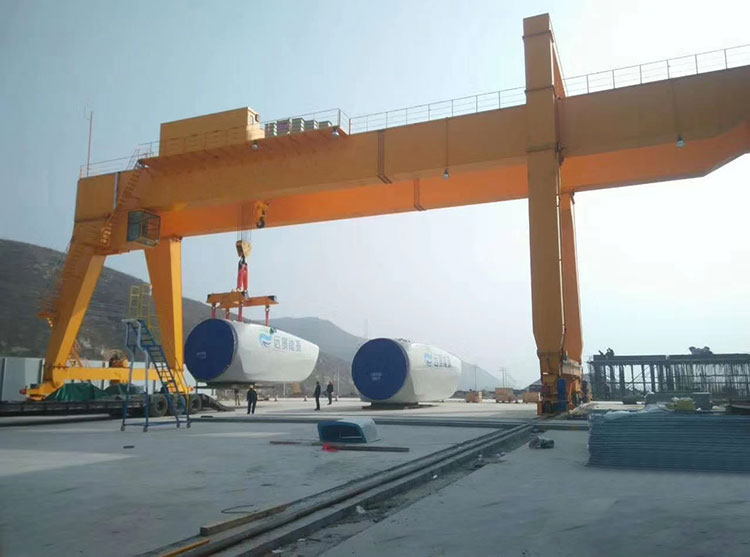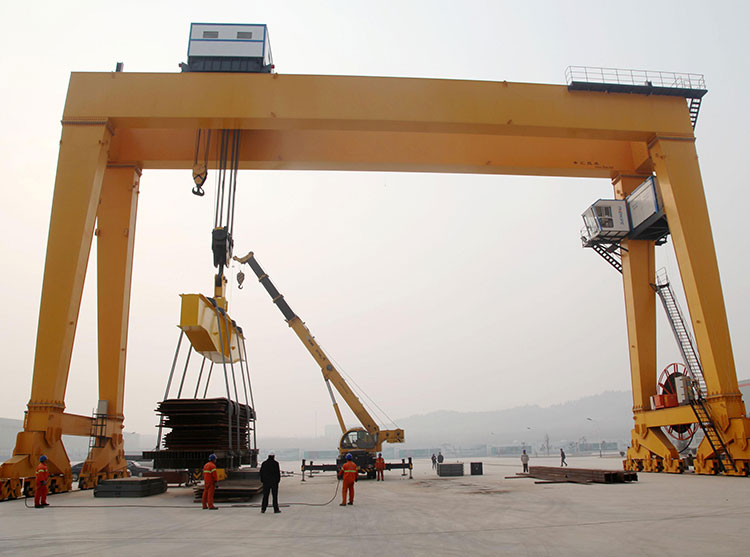Gantry cranes are among the most critical equipment in heavy industries, from steel mills to precast concrete plants. For a 100-ton gantry crane, proper design is not just about meeting lifting requirements – it is about ensuring safety, durability, and operational efficiency. One of the most important factors influencing the design of such heavy-duty cranes is the work duty classification. Understanding how work duty impacts the structural and mechanical design can make the difference between a reliable crane and frequent maintenance headaches or even catastrophic failures.

What is Work Duty Classification?
Work duty classification, sometimes referred to as “duty rating” or “service class,” is a standardized way of defining the operational intensity of a 100 ton gantry crane. It considers factors like:
-
Load frequency: How often the crane lifts and moves loads.
-
Load weight: The percentage of rated capacity the crane typically handles.
-
Operating hours: Daily and annual usage patterns.
-
Environmental conditions: Temperature, humidity, dust, or corrosive environments.
The classification helps engineers anticipate stresses, fatigue, and wear over time. Several standards, such as ISO 4301, DIN 15018, and CMAA (Crane Manufacturers Association of America) specifications, provide guidelines for work duty classes. These standards categorize cranes from light duty (Class A or ISO M1) to very heavy duty (Class F or ISO M8), each implying different design requirements.
For a 100-ton gantry crane, work duty classification is particularly important because the loads involved are massive, and even minor miscalculations can compromise safety and longevity.
Structural Implications of Work Duty Classification
1. Main Girder Design
The main girder is the backbone of a gantry crane for sale, supporting the trolley, hoist, and load. Work duty classification directly affects:
-
Material thickness and cross-section: A crane with a heavy work duty (Class D, E, or higher) must use thicker flanges and webs, or higher-grade steel, to withstand frequent stress cycles.
-
Welding and joint design: High-duty cranes require reinforced welds and sometimes additional stiffeners to prevent fatigue cracking.
-
Deflection limits: For high-duty operations, the crane’s allowable deflection is reduced, ensuring precise load placement even under continuous use.
2. End Carriages and Runway Beams
Gantry cranes move not only vertically but also horizontally along rails or tracks. The work duty classification determines:
-
Wheel load design: More frequent operation increases dynamic forces on wheels, necessitating higher-quality materials or larger wheel diameters.
-
Track or runway reinforcement: Heavy-duty cranes may require additional support beams, bracing, or even continuous welded tracks to distribute loads safely.
-
Structural damping: For high-frequency operation, designers may incorporate vibration-damping measures to reduce wear and operator fatigue.

Mechanical Considerations
1. Hoist and Trolley Mechanisms
The hoist and trolley system is the most heavily stressed mechanical component of a gantry crane. Work duty classification influences:
-
Motor sizing and duty cycles: Heavy-duty goliath cranes need motors designed to run at rated loads for prolonged periods without overheating. A Class C crane lifting near maximum capacity 50 times an hour will require motors with higher thermal ratings than a Class B crane lifting occasionally.
-
Gearbox and drum design: High-duty applications demand gearboxes with robust gears, improved lubrication, and possibly multiple reduction stages. Hoist drums might need thicker walls or higher-quality steel to prevent fatigue.
-
Brake systems: Frequent starts and stops in high-duty cranes necessitate brakes with higher thermal capacity to avoid fading and maintain safety.
2. Control Systems
The operational intensity also dictates the sophistication of control systems:
-
Precision and safety interlocks: For frequent lifts or delicate loads, accurate positioning systems and fail-safes become critical.
-
Automation compatibility: Heavy-duty cranes in repetitive operations may integrate automation, sensors, and load monitoring to maintain efficiency and prevent overloads.
Fatigue and Lifetime Considerations
Fatigue is the primary failure mode for cranes under continuous heavy use. Work duty classification helps designers predict:
-
Cumulative stress: Repeated loading cycles, even below rated capacity, cause material fatigue. Higher duty classes mean more stress cycles per year, requiring thicker, higher-strength components.
-
Maintenance scheduling: Knowing the duty class allows operators to schedule inspections, lubrication, and parts replacement before failures occur.
-
Component selection: Designers may choose high-fatigue-resistant steel, reinforced welds, or roller bearings instead of plain bushings for high-duty cranes.
Environmental and Operational Factors
Work duty classification often interacts with environmental conditions:
-
Outdoor vs. indoor use: High-duty outdoor gantry cranes face wind, rain, and temperature fluctuations, which affect steel expansion, electrical components, and corrosion resistance.
-
Temperature extremes: Cranes operating in freezing or tropical conditions may require special lubrication, motor insulation, or steel grades to prevent brittleness or overheating.
-
Hazardous environments: In corrosive or explosive atmospheres, high-duty cranes may include coatings, stainless steel components, or explosion-proof electrical systems.
Design Optimization Based on Work Duty
Once the duty classification is determined, engineers optimize the crane for:
-
Safety: Ensuring structural integrity under maximum expected loads and dynamic forces.
-
Efficiency: Avoiding overdesign for low-duty cranes, which unnecessarily increases cost.
-
Durability: Extending lifespan through proper material selection, fatigue resistance, and maintenance planning.
-
Cost-effectiveness: Balancing capital cost against expected operational life and maintenance expenses.
For example, a 100-ton gantry crane classified as ISO M6 (heavy duty) lifting loads 100% of capacity multiple times per day will have thicker main girders, higher-rated hoist motors, reinforced wheels, and advanced braking systems. In contrast, a ISO M3 (moderate duty) crane lifting 50% capacity occasionally may have a lighter structure, smaller motors, and simpler controls.
Case Study: Application in a Precast Concrete Plant
Consider a precast concrete facility where 100-ton gantry cranes move large concrete beams daily. Here, the cranes experience:
-
High load frequency (10–20 lifts per hour)
-
Near-full capacity lifts (80–100 tons)
-
Moderate environmental exposure
Designing these cranes as heavy-duty (ISO M6) ensures:
-
Minimal deflection for accurate beam placement
-
Reliable hoist and trolley operation for continuous shifts
-
Reduced risk of fatigue cracks in main girders and welds
-
Extended operational life with predictable maintenance intervals
Neglecting duty classification could result in under-engineered cranes prone to downtime, costly repairs, or even safety incidents.
Conclusion
Work duty classification is a fundamental aspect of 100-ton gantry crane design. It influences every element—from the main girder and end carriage to hoist motors, brakes, and control systems. Ignoring it or underestimating the duty class can lead to excessive wear, unexpected failures, and increased costs. Conversely, an accurately determined duty class allows engineers to create a crane that balances safety, efficiency, durability, and cost-effectiveness.
For heavy industries handling massive loads, understanding and applying work duty classification is not optional—it is essential. Whether the crane operates in a steel mill, shipyard, or precast concrete plant, a well-designed 100-ton gantry crane built according to its work duty classification ensures reliability, safety, and optimal performance over its entire operational life.